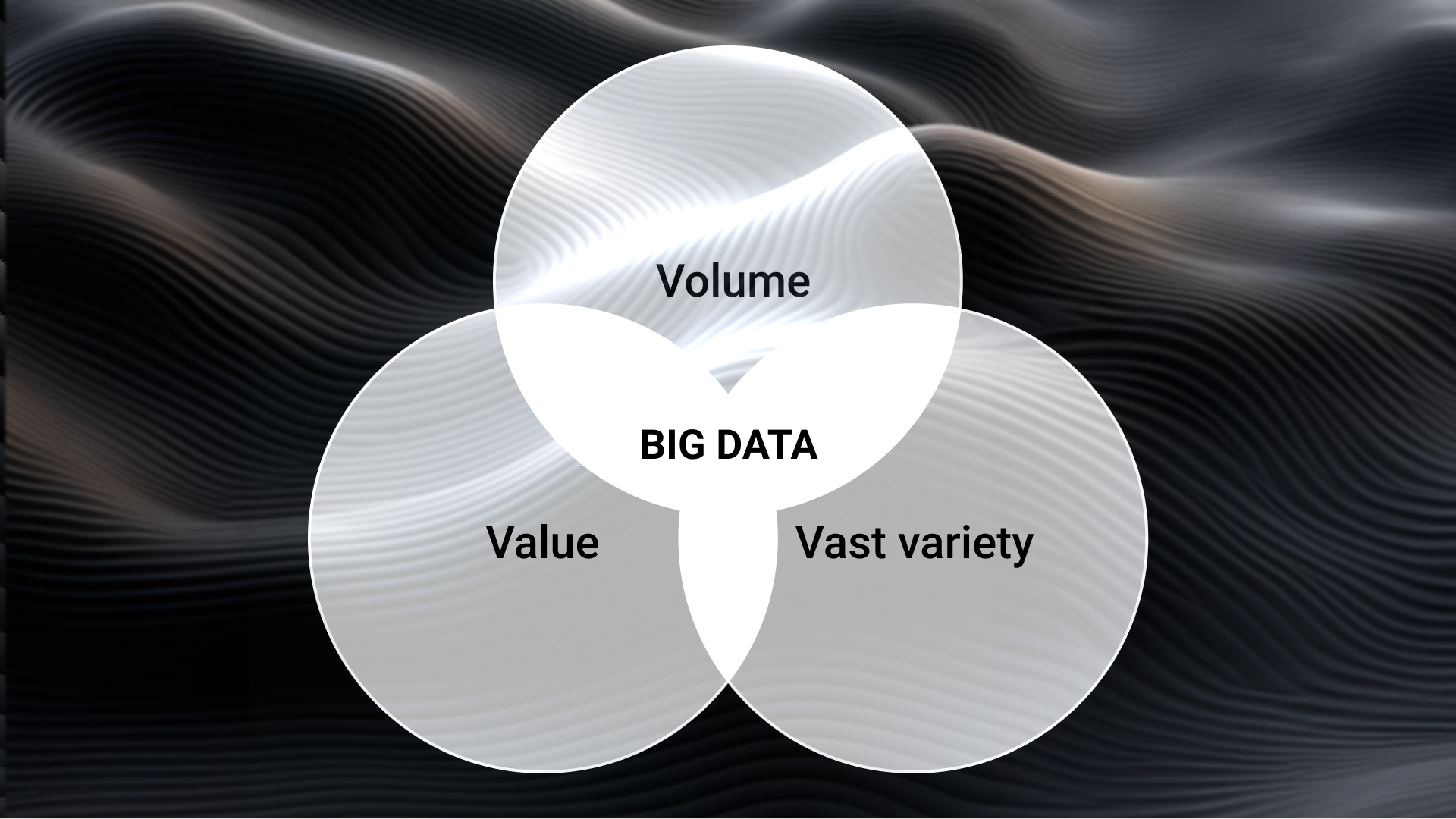Back
How to leverage Big Data and machine learning to increase profits
23.04.2024
Consumers generate so much data every day that they simply cannot be processed manually. It is expected that by 2025 we will have accumulated 175 zettabytes of information — that's 175,000,000,000,000 terabytes. Admit it, you didn't even count the number of zeros, there are so many of them. All in all, that's 175 trillion terabytes. Even if we stopped collecting information today, it would still be impossible to process it manually. Here to save the day are Big Data and machine learning. If you're not already using Big data in your business, you're likely missing out on 20% profit — that's the estimated gain for companies that harness Big Data, reports McKinsey.
That has led to the emergence of tools and technologies that expand the capacity for Big Data processing and analysis. For example, Apache Spark and NoSQL databases, and stream data processing systems. Big Data is widely employed in multiple industries: finance, healthcare, retail, telecommunications. Companies utilize Big Data to make better decisions, optimize processes, and create new products and services.
According to a joint study by VK Cloud and Arenadata, conducted among Russian companies, in 2022 62% of respondents had implemented Big Data solutions.
For comparison, in 2015 just one in ten Russian companies worked with Big Data. When it comes to processing large amounts of data, machine learning is the go-to technology, allowing algorithms to train on their own experience, and make predictions and decisions. The field that combines statistics, data analysis, machine learning, and other Big Data methods is called Data Science. It is one of the major buzz areas in tech.
How do we know it's Big Data in front of us, and not just the regular sort? There are three indicators:
Volume: can be upwards of hundreds of gigabytes per day.
Speed: the volume of data increases exponentially.
Diversity: the data is unstructured and comes in different formats: text, images, audio, or numbers.

Other Big Data indicators can be identified:
Variability: the information flow can be heterogeneous, with bursts and lulls in activity.
Value: the information to be processed may be difficult to analyze, but important for achieving business goals.
Visualization: the analyzed data can be represented visually.
Validity: the data is accurate, and the collection method is valid.
Audience research
One of the main advantages of Big Data and machine learning for digital marketers is the more accurate picture it provides of the target audience and its needs.
Data also delivers a more accurate description of your target audience (TA) — your most frequent customers. Allowing you to run ads only to people who match your TA in terms of demographics, interests, and user experience.
Flocktory works with smart segments, studying typical user behavior patterns. Underlying the segmentation is an analysis of more than 90 million anonymized customer profiles in retail, fintech, and other areas, plus another hundred or so other TA characteristics. Because they are constantly supplemented and refreshed, these profiles are always up to date. For example, data on where the TA lives, its socio-demographic portrait and purchasing power.
Analysis of demand trends
Big Data analysis helps to identify patterns of consumer behavior, detect demand trends ahead of the curve, and stock warehouses with sufficient quantities of goods.
The alternative is unpleasant: all promotional items get sold out in the first hours of the sale, over the coming days users leave the website disappointed, and you lose profit.
What's more, with Big Data you can determine the optimal product price — the one that will bring in sales even out of season, without you operating at a loss.
For example, an online store knows that a customer buys a large pack of cat food every two months and silica gel litter once a month.
What conclusions can we draw from this data:
It makes no sense to show this shopper ads for dog or turtle food;
It makes no sense to offer a discount more than once a month;
It makes a lot of sense to offer additional cat-related products: shampoo, toys, baskets.
Flocktory has developed a tool, called xMail, that allows an affiliate company to send communications via email on behalf of another affiliate. For example, a user quits an online cosmetics store without making a purchase or leaving any contact details. A short while later, they receive a newsletter from an electronics supermarket they subscribed to: in it is a discount promo code from that same cosmetics store they recently visited but left without making a purchase.
Reading this post, you might be thinking: Sure, that's pretty neat, but I'm not Amazon, Marriott, or Uber, I operate a regional online store and don't have millions of customers and hundreds of gigabytes of data to play with. No problem: there are companies that independently collect anonymized user data, analyze it, and, based on the intelligence gained about people, help businesses to improve their bottom line.
Flocktory is one such company. We help retail, fintech, and other companies to manage customer interactions, make data work harder, and solve Performance and CRM tasks. For example, by setting up triggered push notification chains, the retailer METRO increased delivery conversion by 86.8%. We cover this case in detail in our blog.
Optimize pricing in view of demand, competitor offerings, and customer behavior. If you notice a customer leaving your site, employ different engagement techniques and see which one works best.
Manage inventory. Big Data analytics gives insight into patterns and trends in demand — so you won't suddenly run out of stock mid-sale.
Retain customers and increase loyalty. Big Data reveals patterns and indicators of customer churn. You'll be able to proactively identify customers on the verge of quitting your site and take steps to retain them. These measures can take the form of personalized offers or targeted communications. A loyalty program will not only reduce customer churn, but cement relations with customers who trust you, as well as strengthen your overall brand value for your audience.
Contents:
- Bid Data success story
- Big Data indicators
- Tasks that require Big Data
- How to use Big Data in marketing: examples
- What to do if I have no data
- How to increase sales with Big Data: checklist
Big Data success story
Big Data is the vast amounts of data that come from a range of sources, such as social networks, websites, and mobile apps. "Big" refers to any unstructured data that is generated daily and weighs 150 gigabytes or more. How much is that? A text file of the novel "War and Peace" weighs approximately 6 megabytes. So 150 gigabytes is the equivalent of "War and Peace" printed 25,000 times. That amount of data cannot be processed manually.That has led to the emergence of tools and technologies that expand the capacity for Big Data processing and analysis. For example, Apache Spark and NoSQL databases, and stream data processing systems. Big Data is widely employed in multiple industries: finance, healthcare, retail, telecommunications. Companies utilize Big Data to make better decisions, optimize processes, and create new products and services.
According to a joint study by VK Cloud and Arenadata, conducted among Russian companies, in 2022 62% of respondents had implemented Big Data solutions.
For comparison, in 2015 just one in ten Russian companies worked with Big Data. When it comes to processing large amounts of data, machine learning is the go-to technology, allowing algorithms to train on their own experience, and make predictions and decisions. The field that combines statistics, data analysis, machine learning, and other Big Data methods is called Data Science. It is one of the major buzz areas in tech.
How do we know it's Big Data in front of us, and not just the regular sort? There are three indicators:
Volume: can be upwards of hundreds of gigabytes per day.
Speed: the volume of data increases exponentially.
Diversity: the data is unstructured and comes in different formats: text, images, audio, or numbers.

Other Big Data indicators can be identified:
Variability: the information flow can be heterogeneous, with bursts and lulls in activity.
Value: the information to be processed may be difficult to analyze, but important for achieving business goals.
Visualization: the analyzed data can be represented visually.
Validity: the data is accurate, and the collection method is valid.
Tasks that require Big Data
Audience research
One of the main advantages of Big Data and machine learning for digital marketers is the more accurate picture it provides of the target audience and its needs.Data also delivers a more accurate description of your target audience (TA) — your most frequent customers. Allowing you to run ads only to people who match your TA in terms of demographics, interests, and user experience.
Flocktory works with smart segments, studying typical user behavior patterns. Underlying the segmentation is an analysis of more than 90 million anonymized customer profiles in retail, fintech, and other areas, plus another hundred or so other TA characteristics. Because they are constantly supplemented and refreshed, these profiles are always up to date. For example, data on where the TA lives, its socio-demographic portrait and purchasing power.
Analysis of demand trends
Big Data analysis helps to identify patterns of consumer behavior, detect demand trends ahead of the curve, and stock warehouses with sufficient quantities of goods.The alternative is unpleasant: all promotional items get sold out in the first hours of the sale, over the coming days users leave the website disappointed, and you lose profit.
What's more, with Big Data you can determine the optimal product price — the one that will bring in sales even out of season, without you operating at a loss.
Personalization
Big Data analysis also makes it possible to offer users more relevant and personalized solutions.For example, an online store knows that a customer buys a large pack of cat food every two months and silica gel litter once a month.
What conclusions can we draw from this data:
It makes no sense to show this shopper ads for dog or turtle food;
It makes no sense to offer a discount more than once a month;
It makes a lot of sense to offer additional cat-related products: shampoo, toys, baskets.
Retargeting
Now imagine you know much more about the user: how old they are, where they live, how much they earn, what else they buy besides food and on what sites. That will make product recommendations even more tailored. But how to collect such a huge amount of data? There's no need — the missing information can be obtained through email retargeting. Simply put, affiliate newsletters let you reach out to interested users who were on your site but didn't share any contact info.Flocktory has developed a tool, called xMail, that allows an affiliate company to send communications via email on behalf of another affiliate. For example, a user quits an online cosmetics store without making a purchase or leaving any contact details. A short while later, they receive a newsletter from an electronics supermarket they subscribed to: in it is a discount promo code from that same cosmetics store they recently visited but left without making a purchase.
Hypothesis testing
Being able to process large amounts of data and get real-time insights into it lets you test the effectiveness of various marketing tools. For example, you can pilot landing pages and other ad creatives with A/B testing.Resource optimization
Big Data and machine learning help to predict consumers' behavior and identify effective channels to engage with them. Algorithms process historical data on sales and advertising campaigns to predict which strategies will be successful in the future, and make recommendations to optimize advertising outlays.Improving communication
Were you sure your online store's TA was concentrated in one social network and frontloaded your resources there, but the order conversion rate was minimal? Meanwhile, a couple of posts on your Telegram channel brought in hundreds of new customers. That's normal — sometimes hypotheses prove to be unfounded. But to avoid a repeat occurrence, it pays to analyze the data and determine the most effective communication channel.How to use Big Data in marketing: examples
Personalization
The world's biggest e-commerce marketplace, Amazon, uses a recommendation system. The algorithm analyzes the user's purchase history, items they've added to their cart and rated in the past, as well as what other customers have recently viewed or purchased. The result: more than 35% of Amazon sales are driven by recommendations. Flocktory offers a similar personalization tool — product recommendations simplify navigation on the online store, motivate purchases, and increase order conversion.Demand analysis
Starwood Hotels (owned by Marriott International) adjusts its prices based on Big Data. Nightly rates are influenced by local and global economic news, weather, concerts and other cultural events in the vicinity, user booking behavior, and other factors — a tactic that has boosted revenue per room by 5%.Resource optimization
The delivery service Uber Eats analyzed data on how long it takes to prepare a particular dish, making it possible to calculate the precise time when the courier should arrive. Delivery agents were able to take more orders on the road, since they no longer had to wait for restaurants to prepare the food, for which they earned bonuses. Uber's Big Data analytics even includes information from meteorologists, because the weather affects delivery times.Reading this post, you might be thinking: Sure, that's pretty neat, but I'm not Amazon, Marriott, or Uber, I operate a regional online store and don't have millions of customers and hundreds of gigabytes of data to play with. No problem: there are companies that independently collect anonymized user data, analyze it, and, based on the intelligence gained about people, help businesses to improve their bottom line.
Flocktory is one such company. We help retail, fintech, and other companies to manage customer interactions, make data work harder, and solve Performance and CRM tasks. For example, by setting up triggered push notification chains, the retailer METRO increased delivery conversion by 86.8%. We cover this case in detail in our blog.
How to increase sales with Big Data: checklist
Run personalized recommendations based on each user's individual preferences and purchase history. Big Data analytics will help to identify customer segments and preferences. By tailoring messages and offers to specific user groups, you will increase marketing performance and create a sales conversion uplift. In our experience, personalized offers boost conversions by 64%.Optimize pricing in view of demand, competitor offerings, and customer behavior. If you notice a customer leaving your site, employ different engagement techniques and see which one works best.
Manage inventory. Big Data analytics gives insight into patterns and trends in demand — so you won't suddenly run out of stock mid-sale.
Retain customers and increase loyalty. Big Data reveals patterns and indicators of customer churn. You'll be able to proactively identify customers on the verge of quitting your site and take steps to retain them. These measures can take the form of personalized offers or targeted communications. A loyalty program will not only reduce customer churn, but cement relations with customers who trust you, as well as strengthen your overall brand value for your audience.




